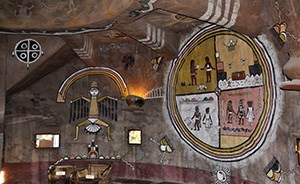
. The Desert View area has been used as a gathering place for thousands of years. Visitors can see a glimpse of the ancient past at the Tusayan Ruin and Museum. Architect Mary Colter modeled Desert View's centerpiece, the Watchtower, after the architecture of the Ancestral Puebloan people of the Colorado Plateau.
ArtPlace America announced in July 2015 that the American Indian Alaska Native Tourism Association (AIANTA), on behalf of the tribal heritage project partnership, received a grant of $500,000 to further arts and culture at Desert View in Grand Canyon National Park. The grant will transform Desert View into a place to celebrate, share, and learn about inter-tribal cultural heritage. AIANTA, along with Grand Canyon National Park and the park's Inter-tribal Advisory Council (ItAC), will specifically use the grant to preserve murals inside the historic Watchtower, continue the Cultural Demonstration Series, and develop inter-tribal tourism opportunities. In addition to ArtPlace America and AIANTA, Grand Canyon Association and the Bureau of Indian Affairs have partnered with Grand Canyon National Park on the reinvigoration of Desert View. A signature project for next year's National Park Service Centennial, the revival of Desert View as a cultural heritage site will provide opportunities for the public to connect with Grand Canyon's Traditionally Associated Tribes. This transformation also ensures that future generations of tribal members and visitors will have an opportunity to make and share meaningful experiences and stories. "This project re-envisions how visitors experience Desert View and the entire park and will lead us and the NPS into the next century. We are grateful for the support of ArtPlace America and the American Indian Alaska Native Tourism Association and the hard work of our Inter-tribal Advisory Council," said Park Superintendent Dave Uberuaga. Grand Canyon's ItAC, established in 2013, is composed of representatives from the park's 11 Traditionally Associated Tribes who collaborate with the NPS on issues that affect each of the tribes and the park. Those tribes–Hopi, Navajo, Zuni, Havasupai, Hualapai, Yavapai-Apache, and five bands of Southern Paiute represented by the Kaibab Paiute–work with the park on programs such as youth development, tribal tourism opportunities, and cultural demonstrations.
One of the programs, the Ancestral Lands Conservation Corps, supported by the NPS Washington Office of Youth Programs, employed ten Navajo and Hopi students for 12 to 22 weeks. The hope is to develop the program further to engage youth from the Traditionally Associated Tribes. Working with Arizona Conservation Corps, the crew worked on multiple projects throughout Grand Canyon, ranging from trail maintenance to creating interpretive programs, as part of the ongoing changes at Desert View.
Made up of foundations, federal agencies, and banks, ArtPlace America focuses on art's role in place-based development. AIANTA, a non-profit organization, helps tribes build for their future and strengthen their cultural legacy. For more about ArtPlace America, visit http://www.artplaceamerica.org/. Go to http://www.aianta.org/ to learn more about the work of AIANTA. To see some of the projects from the Arizona Conservation Corps, check out http://www.azcorps.org/. 
Painting by Gunnar Widforss Desert View Watchtowerby Park Ranger Lisa Collins 
This structure was designed by Mary Elizabeth Jane Colter who is often referred to as the architect of the southwest. She traveled throughout the southwest to find inspiration and authenticity for her buildings. 
Painting by Gunnar Widforss As you get closer to the building you might see how well it blends into the environment. It is difficult to tell where the rock of the canyon walls end, and the tower begins. She said:
To obtain this result she insisted that the rocks not be cut or worked, so they would not lose the:

She had seen this pattern at Chaco Canyon and thought it would break the monotony of this Watchtower. The built in cracks which are patterned from some of the ancient towers she had seen are deliberately designed. There are actual petroglyphs on some of the stones which were brought here from near Ash Fork. 
Upon this framework, each exterior stone was selected and carefully placed to ensure exactly the look Mary Colter was hoping to obtain for she was a stickler for detail. At one point she had to leave for a day and the workmen continued to put on stone, completing two layers. When she returned, she was not satisfied with one stone on the newly laid layers, and the men had to take the whole thing down and re-do it to her exacting specifications. Her attention to accuracy of detail was amazing. 
Painting by Gunnar Widfross The Kiva Room had, up until recently, been used for retail space. On January 1, 2015, the National Park Service took over management of the building with the intent of restoring Mary Colter's original vision of the building. 
The ceiling images, painted by Fred Geary, are recreations of images from Abo Rockshelter, now part of Salinas National Monument in New Mexico. 
The observation area on the top floor of the tower is without decoration which might detract from the beautiful panoramic views of the Grand Canyon. The Watchtower stands today, partly as a monument to Ms. Colter’s careful attention to detail, her enchantment with the southwest, and her commitment to the cultural preservation. Related Information:Desert View Services and Hours of OperationDesert View Drive (Hwy 64) Scenic Road
Visit our keyboard shortcuts docs for details
Perched on the edge of Grand Canyon, a surprising stone tower celebrates ancient mysteries of the Southwest. The Desert View Watchtower is a monument to a time, a place and a people. Discover what inspired architect Mary Colter to build the Watchtower in 1932. |
Last updated: December 7, 2018
